


“Rīga is beautiful. I love her. But do I know her?” –
opera soloist Mariss Vētra
The history of Old Rīga is the history of all of Rīga – the place where the Middle Ages encounter the present day. The Old City is a place where religious and lay power co-exist. There are ministries, artists’ workshops, offices, cafés, banks, salons, galleries, antiques shops and pubs. The centuries have left their trace in Old Rīga. Old buildings are being replaced by new ones. Each of the many centuries has left its mark, and that is certainly true of the period of Art Nouveau. Old Rīga is full of wonderful Art Nouveau buildings – structures which bring colour and romance to the Medieval city.
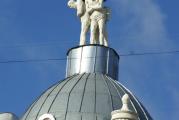
This is an eclectically decorative Art Nouveau building. Its original owner was a retailer of books and antiquities called Zihmanis. The decorations on the façade of the building include sculptures typical of the style of Eclecticism – elements of seashells and ivies, as well as different geometric ornaments. Particularly accented is the corner tower of the building. The balcony is held up by Atlas, presented here as a muscular and only partly clad god.

In terms of artistic elegance, this eclectically decorated Art Nouveau building stands out in Old Rīga, not least because of its ornate façade. The central element in the building is the bay window encircled with chestnut leaves and flowers. At the centre of the bay window – a gilded representation of the sun, something that can be seen in various versions in the façades of many Art Nouveau buildings in Rīga. It symbolises the flourishing and restoration of life itself, and it speaks to this particular period in Rīga’s history. The façade was renovated in 1983, and the building now is home to offices and a café.
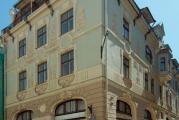
One of the very first Art Nouveau buildings in Rīga, this one initially belonged to a book publisher called Alexander Grosset. The building is a classical example of decorative Art Nouveau, which an asymmetrical façade which is fully in line with the design of the building itself. The façade is full of stylised plants – irises, dandelions reedmace, etc. On the Audēju Street façade, there is a relief presenting a stylised apple tree – the symbol of creative power. There are apples in the branches of the tree, and they symbolise wealth, productivity and welfare. There’s also a small bay window with mascarons of screaming and surprised faces on either side. The upper floor is a mansard with elegant metal railings. The façades were restored in the late 1960s, and the building now houses a design institute.
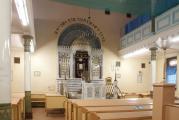
In the early 20th century, Rīga’s Jewish community purchased land in the heart of Old Rīga, on Peitavas Street, to build a synagogue. The building’s longer façade runs along Peitavas Street, and that is in line with traditional construction principles for synagogues. Elements of Art Nouveau decoration can be seen – architectural forms from Egypt grant the building a particularly rich appearance. The main façade is decorated with motifs of palm branches and the star of David. The interior of the building is full of colour and decoration, and the columns are also decorated with Egyptian motifs.
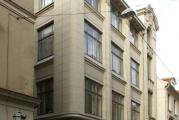
This is a building which brings together elements of Neo-classicism and vertical Art Nouveau. Figures of children are seen on the entrance portal. Such figures usually represented intermediaries between the spiritual and the material world. Art Nouveau stained glass is seen in the windows of the stairwell. The building is now full of offices.
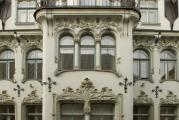
A decorative Art Nouveau building owned initially by a successful businessman called Detmann. He was one of the owners of the Union stock company. The façade of the building is decorated with stylised plants – reeds, poppies, narcissus and chestnut leaves. Elements of flora are also seen in the balcony railings and the metalwork on the roof. The main accent of the building is the ornate and massive two-story bay window, decorated richly with motifs of the poppy. The dog above the bay window is guarding the building. The initials of the original owner can also be seen in the façade.
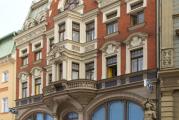
Detmann also owned this decorative Art Nouveau building. It was built in the style of Eclecticism, but with decorative elements of Art Nouveau. Different materials of various colours were used in the façade. The symmetrical façade is accented with a bay window that has balconies on either side. The entrance portal is accented with sculptures and mascarons. The pilasters at the corner of the building turn into expressive sculptures of a female and a male figure. Art Nouveau metal carvings decorate the windows of the two lower floors, and more can be found on the roof of the building.
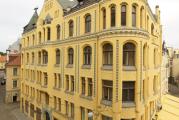
This building resembles a Medieval fortress. It has two symmetrical corner towers featuring sculptures of cats. The story is that the owner of the building was a wealthy Latvian merchant who was so offended at his rejection for membership in the Great Guild that he put the cats on the roof with tails raised in the direction of the Guild. The building has forever been known as the “Cat Building”. The façade of the structure features geometrical ornaments, while the central portal is decorated with stylised plants and mascarons. The portal on Zirgu Street is decorated with figural reliefs.
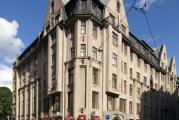
This used to be the building of a mutual aid society for farmers in the Vidzeme province of the Russian Empire, and it was built in the style of vertical Art Nouveau. The entrance portal is decorated by sculptural reliefs of copper, showing images from Ancient Greek mythology – Asclepius, the demigod of medicine, and the goddess of destiny, who symbolised the flow of life, along with health and work. The Ministry of Education and Science of the Republic of Latvia is housed here now.
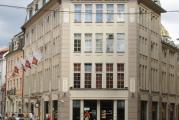
This building was put up for the Northern Bank, and it represents the style of vertical Art Nouveau. The façade has decorative and ornamental reliefs which symbolise the idea of work and its results, also focusing on the bank as a symbol of welfare. August Foltz designed the reliefs. The Parex Bank has a branch in the building now, and when it moved in, it restored several of the building’s historical interiors.
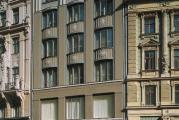
This is a building from the period of late Art Nouveau and elements of Neo-classicism are seen in its decorations. The façade features decorative reliefs with medallions. The upper floor of the building is accented with pilasters which feature Egyptian motifs.
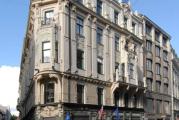
This eclectically decorative Art Nouveau building features a wealth of sculpture on its façades. These were the work of the sculptors Sigismund Otto and Oswald Wassil. The building originally belonged to a man called Bobrov. The façades feature many bay windows and balconies decorated with metal. Above the Smilšu Street façade’s bay window, there are two female figures holding out a crown of flowers. They symbolise beauty and harmony. The entrance portals are decorated with expressive female mascarons with closed eyes. There are shops on the first floor of the building today, along with a sweets shop and small café where visitors can enjoy a cup of coffee in a restored Art Nouveau interior.
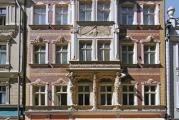
This is one of the best examples of Art Nouveau architecture in Rīga. The façade is made of red brick, plaster and colourful tiles. At the centre of the façade is a two-story bay window supported by caryatides and figures of Atlas. There is also an oak tree with a mighty system of roots. The caryatide under the bay window presents the most beautiful image of a woman in Art Nouveau architecture in Rīga. At the centre of the bay window is the figure of a peacock – a key Art Nouveau symbol of beauty and self-confidence. Above it is the winged head of a woman – a symbol of the sun. The corner pilasters of the bay window have reliefs showing an owl and a squirrel, along with the owner’s initials and the year of construction. The façade of the building has many ornamental Art Nouveau reliefs and sculptures, while the windows of the mansard feature a stylised depiction of the sun.

The former bank of the First Rīga Mutual Lending Association was housed in a building which represents the style of rational Art Nouveau. It has decorations in the style of Neo-classicism, and the façade is decorated with gilded mosaics between the windows. The DnB Nord bank is now housed in the structure.

The Russian insurance company “Rossiya” was the first occupant of this building, which was designed by an architect from St Petersburg. The building has several asymmetrical towers and a bay window, which makes the structure look romantic indeed. The building was finished with light brown plaster in combination with other elements. The dynamism of the façade is accented by balconies, bay windows, Art Nouveau plant motifs, mascarons and reliefs. The corner façade is emphasised with a bay window and small tower. Under the bay window we see an allegorical representation of a woman bearing a shield decorated with the eight-point star of the morning. Sculptor Oswald Wassil produced the figure. The building was reconstructed in 1999 for office space. A restaurant is on the first floor.
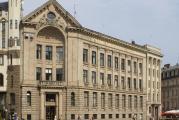
The former home of the Rīga Commercial Bank, this is a Neo-classicist building. An allegorical composition which symbolises wealth and welfare can be seen along with the herald of the city of Rīga. The sculptures on the building are in Art Nouveau style. Radio Latvia is now housed in the structure.
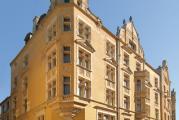
The building was erected by the construction magnate Ludwig Neuburg. Elements of Eclecticism and Art Nouveau can be seen in the design of the building, which replaced several older buildings in Old Rīga. The architect divided the building up into various parts so as better to place it into the environment of the Old City. Each had a different decorative interpretation. Eclectic elements of Neo-Renaissance design interweave with Art Nouveau ornaments. The façade features balconies, bay windows and stylised plant ornaments. The central entrance portal is decorated by a monumental woman’s mask against the background of the sun.
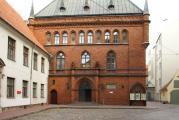
At the conclusion of the tour, we recommend that you stop by at the Rīga Museum of History and Shipping, which is one of the oldest museums in Europe. Dating back to 1773, it has a collection which is primarily based on the private collection of the physician Nikolaus von Himsel. The structure is part of the Dome Cathedral complex. A collection of original Art Nouveau objects can be seen in the museum.